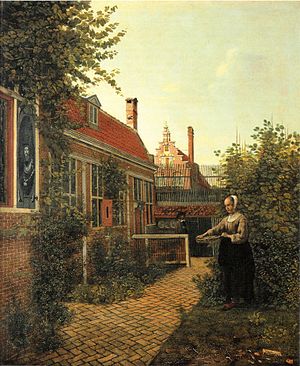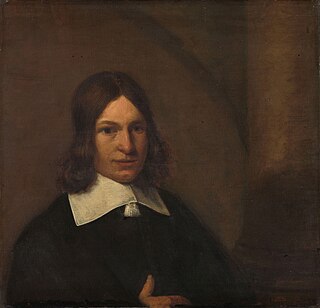
Pieter Hendricksz. de Hooch, was a Dutch Golden Age painter famous for his genre works of quiet domestic scenes with an open doorway. He was a contemporary, in the Delft Guild of St. Luke, of Jan Vermeer with whom his work shares themes and style. De Hooch was first recorded in Delft on 5 August 1652, when he and another painter, Hendrick van der Burgh witnessed the signing of a will. He was active in 1683, but his date of death is unknown.
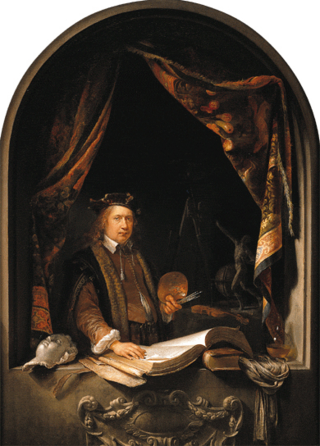
Gerrit Dou, also known as GerardDouw or Dow, was a Dutch Golden Age painter, whose small, highly polished paintings are typical of the Leiden fijnschilders. He specialised in genre scenes and is noted for his trompe-l'œil "niche" paintings and candlelit night-scenes with strong chiaroscuro. He was a student of Rembrandt.
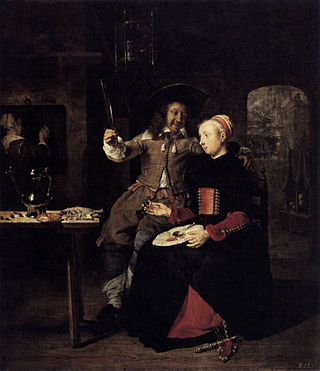
Gabriël Metsu (1629–1667) was a Dutch painter of history paintings, still lifes, portraits, and genre works. He was "a highly eclectic artist, who did not adhere to a consistent style, technique, or one type of subject for long periods". Only 14 of his 133 works are dated.

Hendrick van der Burgh, was a Dutch Golden Age painter known for his genre scenes. He was related to contemporary Pieter de Hooch, as step brother following the marriage of his sister, Jannetge, to de Hooch. He is considered part of the Delft School, although his artistic output was relatively small, he is known for prints and portraits, with the monogram "HVB".

The Courtyard of a House in Delft is a 1658 oil painting by Pieter de Hooch, located in the National Gallery, London. The painting is considered typical of de Hooch's middle period, in which he painted detailed portrayals of Dutch domestic architecture and courtyards. The painting is signed and dated "P.D.H. / A 1658" on the archway to the left.

A Boy Bringing Bread is an oil-on-canvas painting by the Dutch painter Pieter de Hooch. It is an example of Dutch Golden Age painting and is part of The Wallace Collection, on display at East Galleries II in London. The painting was likely painted soon after De Hooch's arrival in Amsterdam from Delft in the early 1660s.
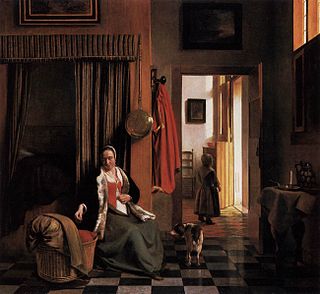
Woman lacing her bodice beside a cradle is an oil-on-canvas painting by the Dutch painter Pieter de Hooch, created c. 1660–1663. It is part of the collection of the Gemäldegalerie, Berlin.

Mother with a Child and a Chambermaid (1665–1668) is an oil-on-canvas painting by the Dutch painter Pieter de Hooch. It is an example of Dutch Golden Age painting and is part of the collection of the Amsterdam Museum.
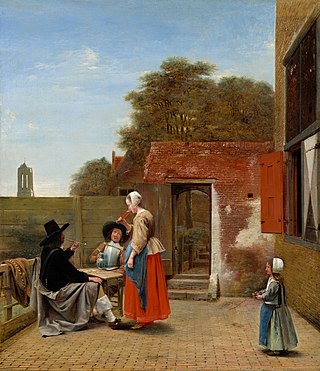
A Dutch Courtyard (1658–1660) is an oil-on-canvas painting by the Dutch Golden Age painter Pieter de Hooch. The original resides in the collection of the National Gallery of Art in Washington, D.C. A later, altered replica also exists, part of the collection of the Mauritshuis Museum in The Hague.

Lady and Her Cook is an oil-on-canvas painting by the Dutch painter Pieter de Hooch, created c. 1660. It is part of the collection of the Hermitage Museum, in St. Petersburg.

Cardplayers in a Sunlit Room (1658) is an oil-on-canvas painting by the Dutch painter Pieter de Hooch; it is an example of Dutch Golden Age painting and is now in the Royal Collection, and on display at the King's Gallery in London.

The Bedroom (1658–1660) is an oil-on-canvas painting by the Dutch painter Pieter de Hooch. It is an example of Dutch Golden Age painting and is part of the collection of the National Gallery of Art in Washington, D.C., United States.

The Bedroom (1658–1660) is an oil-on-canvas painting by the Dutch painter Pieter de Hooch. It is an example of Dutch Golden Age painting and is part of the collection of the Staatliche Kunsthalle Karlsruhe in Germany.

A Woman Drinking with Two Men is a 1658 painting by Pieter de Hooch, an example of Dutch Golden Age painting and is part of the collection of the National Gallery, London.
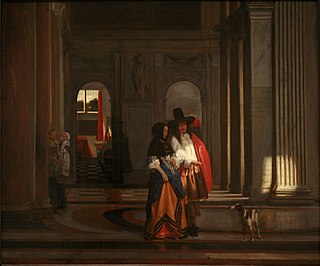
Going for a Walk in the Amsterdam Town Hall is an oil-on-canvas painting by the Dutch painter Pieter de Hooch. It is an example of Dutch Golden Age painting and is now in the Musée des Beaux-Arts de Strasbourg, inventory number 213. This piece overwhelmingly likely originated during De Hooch's Amsterdam period considering the local setting.

Interior of a Kitchen with a Woman, a Child and a Maid is an oil-on-canvas painting by the Dutch painter Pieter de Hooch. It is an example of Dutch Golden Age painting and is part of a private collection.
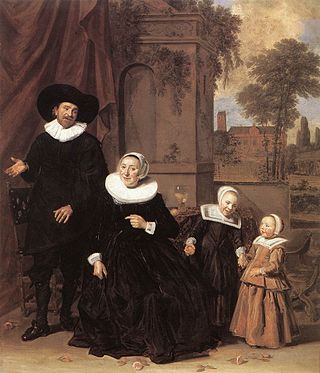
Portrait of a Dutch Family is an oil-on-canvas painting by the Dutch Golden Age painter Frans Hals, painted c. 1635 and now in the Cincinnati Art Museum, Cincinnati.

Interior with a Man Reading a Letter and a Woman Sewing is an oil painting on canvas executed c. 1670–1674 by the Dutch artist Pieter de Hooch, now in the private Kremer Collection.
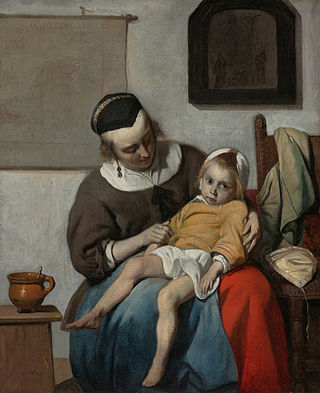
The Sick Child or The Sick Girl is an oil on canvas genre painting by the Dutch artist Gabriël Metsu, created c. 1660. It has been held by the Rijksmuseum, in Amsterdam, since it was bought in 1928, with assistance from the Vereniging Rembrandt at a sale of works from the collection of Oscar Huldschinsky in Berlin.

Game of Skittles is an oil-on-canvas painting by the Dutch painter Pieter de Hooch. It is an example of Dutch Golden Age painting and is part of the Cincinnati Art Museum's collection. The picture was most likely painted around de Hooch's first Amsterdam period, seemingly occurring during the years preceding 1670.
